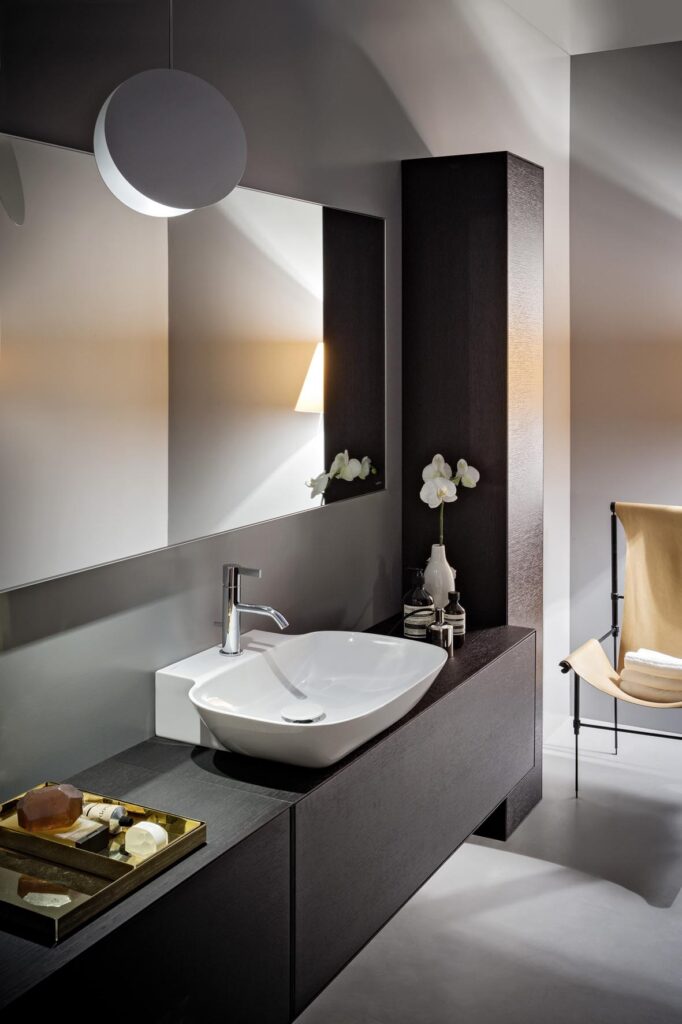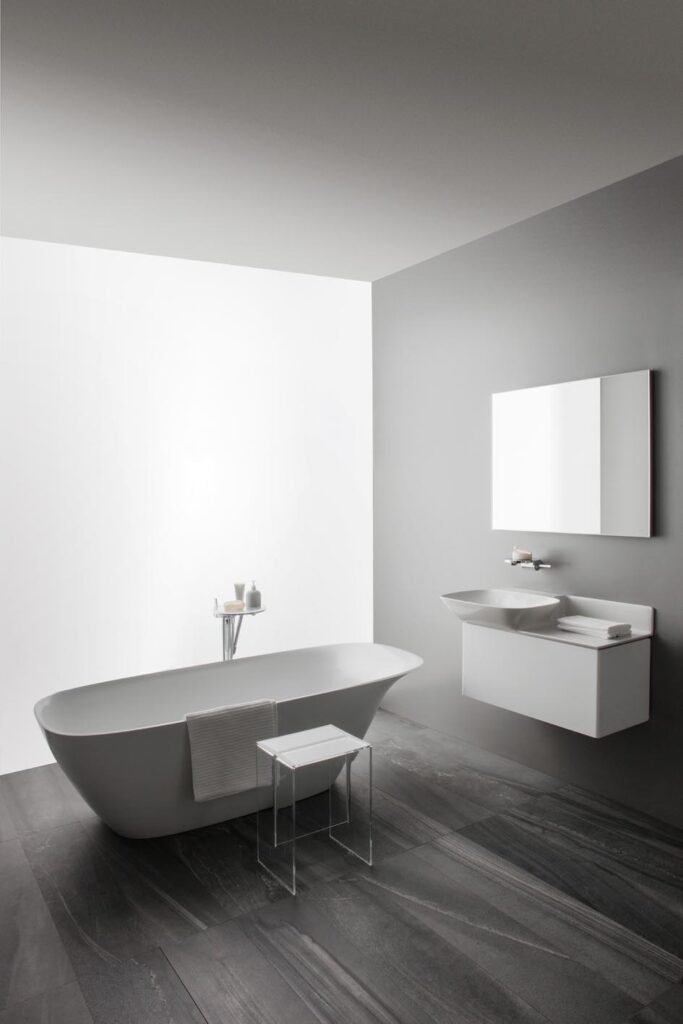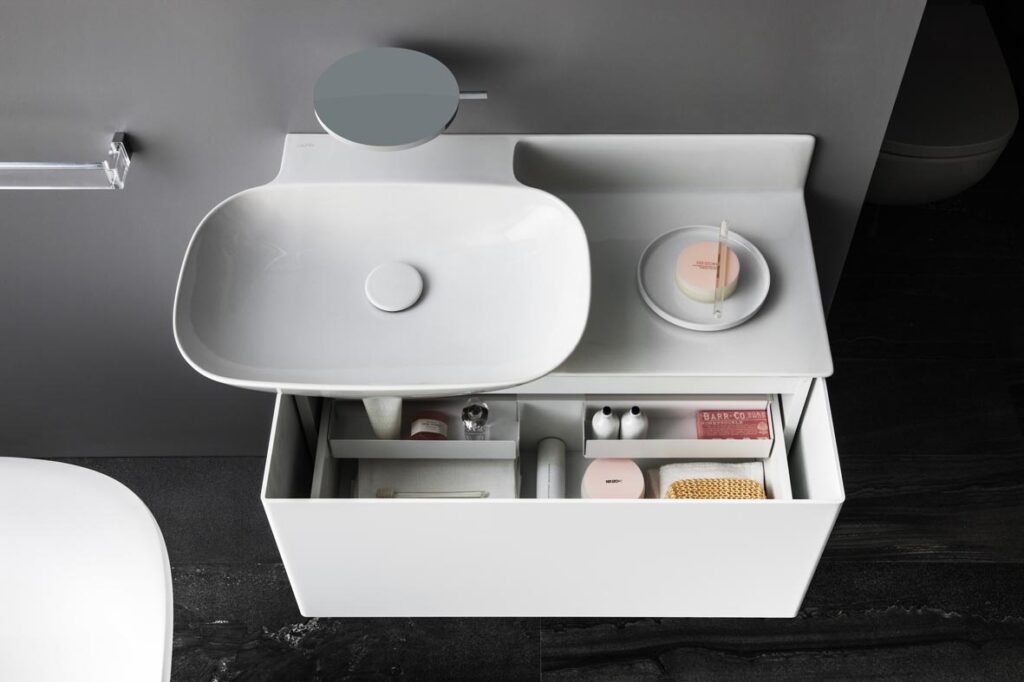French designer Toan Nguyen talks to Dominic Lutyens about his collaboration with Laufen and his philosophy – design pared down to its essential elements.
 How and when did you first come to collaborate with Laufen? What products have you already created for Laufen? Are these made of SaphirKeramik too?
How and when did you first come to collaborate with Laufen? What products have you already created for Laufen? Are these made of SaphirKeramik too?
Toan Nguyen: It all started when I met Marc Viardot, Laufen’s Director of Marketing and Products in 2011, at the Milan Furniture Fair, where I was launching my outdoor sofa collection, Mu for Dedon. We talked about collaborating, and this led to me designing my first product for Laufen, the Antero urinal for the contract market, which is produced in Laufen, Switzerland. It isn’t made of SaphirKeramik but of vitreous china. It later won a Red Dot award.
How did you come to collaborate with Laufen on your new design?
Laufen wanted to take things further with their exploration of SaphirKeramik, and invited several designers to take part in this, including myself. Laufen and the designers discussed how to use this material and try out different approaches with the goal of creating a new generation of washbasins. This echoed my own aim to create a practical rather than a conceptual product. My starting point was to take an archetypal washbasin and transform it into something different. I ended up creating a wall-mounted washbasin incorporating a shelf to one side. The shelf takes the place of the wider area normally found around a basin. Eliminating the wider edge around a conventional basin allows for a more generously sized washbasin. Its emphasis is more on lines and surface than on volume. But it’s not just about surface as the washbasin is made of ceramic and still has all its qualities – its materiality, a physical quality which you can touch and feel.

What appealed to you about your latest collaboration with Laufen? Was it the company’s culture of promoting creativity? Or, more specifically, the creative possibilities offered by SaphirKeramik?
Both. My first experience working with Laufen had already been very positive. For me, a good relationship with a company is a vital starting point. I believe you can only create good design with a company’s support. Laufen gave me a relatively open brief, which was fantastic. We considered many production methods. And Laufen’s response to trying out new things was very positive – they always said: “Why not?” And for me it was important to push the limits of the product and its production process.

What was it like for you to work with SaphirKeramik? What associations does it have for you? Do you think it has its own design language?
It was incredible. It was a great opportunity to work with a new material, which hardly ever happens. It’s dense and strong yet very fine, its lines very precise. It’s like traditional ceramic in that it’s hygienic and shares the same production processes – moulding, glazing and firing. But, while it’s recognisably made of ceramic, it’s also modern, very high-performance. Its thin walls provide the opportunity to create very graphic, minimalist shapes. Its radii can be tight yet they don’t feel sharp but smooth. Overall, SaphirKeramik is sensual, tactile. You can make washbasins out of resin, but ceramic is always the best material. Most of us prefer to eat off a ceramic rather than a plastic plate. We like to drink our coffee from china cups. Yet I like the fact that ceramic is made using an industrial process and is part of our everyday lives. It’s not elitist.
Are there any similarities – aesthetic or otherwise – between your designs for Laufen and your other work?
Not really as I’m not really interested in having one, signature style. That said, functionality is important to me. If people use my washbasin as a normal washbasin, this will make me very happy. I wanted it to be an object that doesn’t shout for attention or look extreme. Yet my washbasin is discreetly innovative. When I designed it, I wanted to eliminate all unnecessary elements – the thickness, volume and visual weight. I wanted to create a washbasin reduced to its essential form and simple lines.

Were any of your pieces modified after the prototypes were exhibited? And can you tell us about how you have extended the range?
No, there were no modifications. Initially, I created one design – a wall-mounted washbasin with a shelf, which I consider an iconic piece. This was created as the start of a collection and established its design language. After Milan, Laufen and I decided to extend the collection with three related designs: wall-mounted washbasins, semi-inserted ones and bowls. The new wall-mounted washbasins have a shelf and come in two sizes, making them versatile as they can be used in smaller bathrooms. Although I see the shelf on the other washbasin as an important element – it is very functional and makes the basin iconic – it is not essential. After Milan, I also wanted to complete the collection with some related and unique pieces of furniture that complement the ceramic range. These include a vanity unit in various sizes to house the different washbasin designs and a tall bathroom cabinet. These all have doors made of aluminium covered in a wood veneer or white lacquer. The aluminium is very thin and strong, in keeping with the spirit of SaphirKeramik. And I’ve created two bathtub designs made of solid-surface material. They have very thin walls – making them aesthetically related to the designs in SaphirKeramik – but, by contrast, their interior is soft and rounded.
Images and interview courtesy Laufen. For more information visit laufen.com































